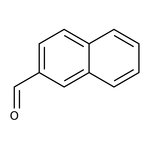Search Thermo Fisher Scientific
Thermo Scientific Chemicals
2-Naphthaldehyde, 98%
CAS: 66-99-9 | C11H8O | 156.184 g/mol
Catalog number ALFB25157.14
View Price:Sign InSign in to see your account pricing. Need an account? Register with us today.
Quantity:
25 g
Specifications
Chemical Name or Material2-Naphthaldehyde
CAS66-99-9
Health Hazard 1H302-H315-H319-H335
Health Hazard 2GHS H Statement
H301-H315-H319-H335
Toxic if swallowed.
Causes skin irritation.
Causes serious eye irritation.
May cause respiratory irritation.
H301-H315-H319-H335
Toxic if swallowed.
Causes skin irritation.
Causes serious eye irritation.
May cause respiratory irritation.
Health Hazard 3P261-P264b-P270-P271-P280-P301+P312-P302+P352-P304+P340-P305+P351+P338-P312-P330-P332+P313-P362-P501c
View more
2-Naphthaldehyde aids in stereo-selective formation of bicyclo 2-siloxy-2-alkoxyoxetanes. It is also used as catalytic agent and petrochemical additive.
This Thermo Scientific Chemicals brand product was originally part of the Alfa Aesar product portfolio. Some documentation and label information may refer to the legacy brand. The original Alfa Aesar product / item code or SKU reference has not changed as a part of the brand transition to Thermo Scientific Chemicals.
Applications
2-Naphthaldehyde aids in stereo-selective formation of bicyclo 2-siloxy-2-alkoxyoxetanes. It is also used as catalytic agent and petrochemical additive.
Solubility
Soluble in hot water.
Notes
Store at -20°C. Air Sensitive. Store away from string bases and oxidizing agents.
2-Naphthaldehyde aids in stereo-selective formation of bicyclo 2-siloxy-2-alkoxyoxetanes. It is also used as catalytic agent and petrochemical additive.
Solubility
Soluble in hot water.
Notes
Store at -20°C. Air Sensitive. Store away from string bases and oxidizing agents.
RUO – Research Use Only
General References:
- K Wichmann; T Krusius; R Sinervirta; J Puranen; J Jänne. Studies on structure-activity relationship of gossypol, gossypol ethers and three naphthaldehydes in the inhibition of spermatozoal metabolism. Contraception.1986, 33, (5), 519-528.
- Manabu Abe; Masayuki Ikeda; Yasuo Shirodai; Masatomo Nojima. Regio- and stereo-selective formation of 2-siloxy-2-alkoxyoxetanes in the photoreaction of cyclic ketene silyl acetals with 2-naphthaldehyde and their transformation to aldol-type adducts. Tetrahedron Letters.1996, 37, 5901-5904.



